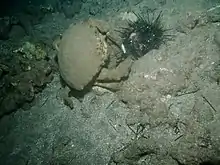| Dromiacea Temporal range: | |
|---|---|
 | |
| Dromia dormia (Dromioidea: Dromiidae) feeding on a sea urchin | |
| Scientific classification | |
| Domain: | Eukaryota |
| Kingdom: | Animalia |
| Phylum: | Arthropoda |
| Class: | Malacostraca |
| Order: | Decapoda |
| Suborder: | Pleocyemata |
| Infraorder: | Brachyura |
| Section: | Dromiacea De Haan, 1833 |
| Superfamilies | |
Dromiacea is a group of crabs, ranked as a section. It contains 240 extant and nearly 300 extinct species.[1] Dromiacea is the most basal grouping of Brachyura crabs, diverging the earliest in the evolutionary history, around the Late Triassic or Early Jurassic. Below is a cladogram showing Dromiacea's placement within Brachyura: [2] [3]
| Brachyura |
| ||||||||||||||||||||||||
The larvae of Dromiacea resemble those of the Anomura more closely than those of other crabs. This may simply reflect their basal position in the crab phylogeny. The superfamily Eocarcinoidea, containing Eocarcinus and Platykotta, was previously considered to be a member of the Dromiacea, but has since been transferred to the Anomura.[4]
The fossil record of Dromiacea reaches back at least as far as the Jurassic,[5] and, if Imocaris is indeed a member, into the Carboniferous.[6]
Dromiacea primarily consists of two groups of superfamilies - Dromioidea and Homoloidea. See the below cladogram:[2]
| Dromiacea |
| ||||||||||||||||||
Recent studies have found that some of the families may not be monophyletic, but rather paraphyletic.[2]
- The Dromioidea family Dromiidae may be paraphyletic with respect to Dynomenidae
- The Homoloidea family Homolidae is paraphyletic with respect to Latreilliidae
References
- ↑ Sammy De Grave; N. Dean Pentcheff; Shane T. Ahyong; et al. (2009). "A classification of living and fossil genera of decapod crustaceans" (PDF). Raffles Bulletin of Zoology. Suppl. 21: 1–109. Archived from the original (PDF) on 2011-06-06.
- 1 2 3 Ling Ming Tsang; Christoph D. Schubart; Shane T. Ahyong; Joelle C.Y. Lai; Eugene Y.C. Au; Tin-Yam Chan; Peter K.L. Ng; Ka Hou Chu (2014). "Evolutionary History of True Crabs (Crustacea: Decapoda: Brachyura) and the Origin of Freshwater Crabs". Molecular Biology and Evolution. Oxford University Press . 31 (5): 1173–1187. doi:10.1093/molbev/msu068.
- ↑ Wolfe, Joanna M.; Breinholt, Jesse W.; Crandall, Keith A.; Lemmon, Alan R.; Lemmon, Emily Moriarty; Timm, Laura E.; Siddall, Mark E.; Bracken-Grissom, Heather D. (24 April 2019). "A phylogenomic framework, evolutionary timeline and genomic resources for comparative studies of decapod crustaceans". Proceedings of the Royal Society B. 286 (1901). doi:10.1098/rspb.2019.0079. PMC 6501934. PMID 31014217.
- ↑ Jérôme Chablais; Rodney M. Feldmann; Carrie E. Schweitzer (2011). "A new Triassic decapod, Platykotta akaina, from the Arabian shelf of the northern United Arab Emirates: earliest occurrence of the Anomura" (PDF). Paläontologische Zeitschrift. 85: 93–102. doi:10.1007/s12542-010-0080-y.
- ↑ J. W. Wägele. "On the influence of fishes on the evolution of benthic crustaceans". Journal of Zoological Systematics and Evolutionary Research. 27 (4): 297–309. doi:10.1111/j.1439-0469.1989.tb00352.x.
- ↑ Frederick Schram & Royal Mapes (1984). "Imocaris tuberculata, n. gen., n. sp. (Crustacea: Decapoda) from the upper Mississippian Imo Formation, Arkansas". Transactions of the San Diego Society of Natural History. 20 (11): 165–168.
